IMS 418 - Social Media Marketing & Online Community Management
Spring 2022
Company Overview
Disney, also known as The Walt Disney Company is a multinational entertainment company. The mission of The Walt Disney Company is to “entertain, inform and inspire people around the globe through the power of unparalleled storytelling, reflecting the iconic brands, creative minds and innovative technologies that make ours the world's premier entertainment company.” Since Disney is such a large company, I will be focusing more on Disney Parks, but a lot of the following aspects can be applied to the brand as a whole. The goal of Disney Parks is to help families create magical memories that will last a lifetime.
Disney’s main values as a brand are both employee and customer satisfaction, citizenship, health and safety, and inclusion within the parks. Disney is always finding new ways to implement technology to create immersive experiences in hopes of instilling happiness, imagination, and inspiration within park guests. In terms of primary audience, Disney’s target audience is very diverse as Disney targets families which can realistically be people of any age. When talking specifically about the parks, Disney’s target audience would be adults buying tickets to the parks for their families to enjoy the Disney experience.
Disney currently has an estimated market capitalization of $240 billion. The Disney Parks, Experiences, and Products revenue is estimated to be about $30 billion for this year, 2022. The three different parks in Disney World alone make approximately $17 billion a year. Disney’s most popular social media platforms are Twitter, Instagram, and Tik Tok, with a total combined audience of approximately 8 million users. Disney Parks Instagram currently has 2 million followers, Twitter has 2.1 million followers, and Tik Tok has 4.6 million followers. Additionally, Disney has accounts on Facebook, YouTube, Snapchat, and LinkedIn but they are not as popular.
Personas & Customer Journey Maps
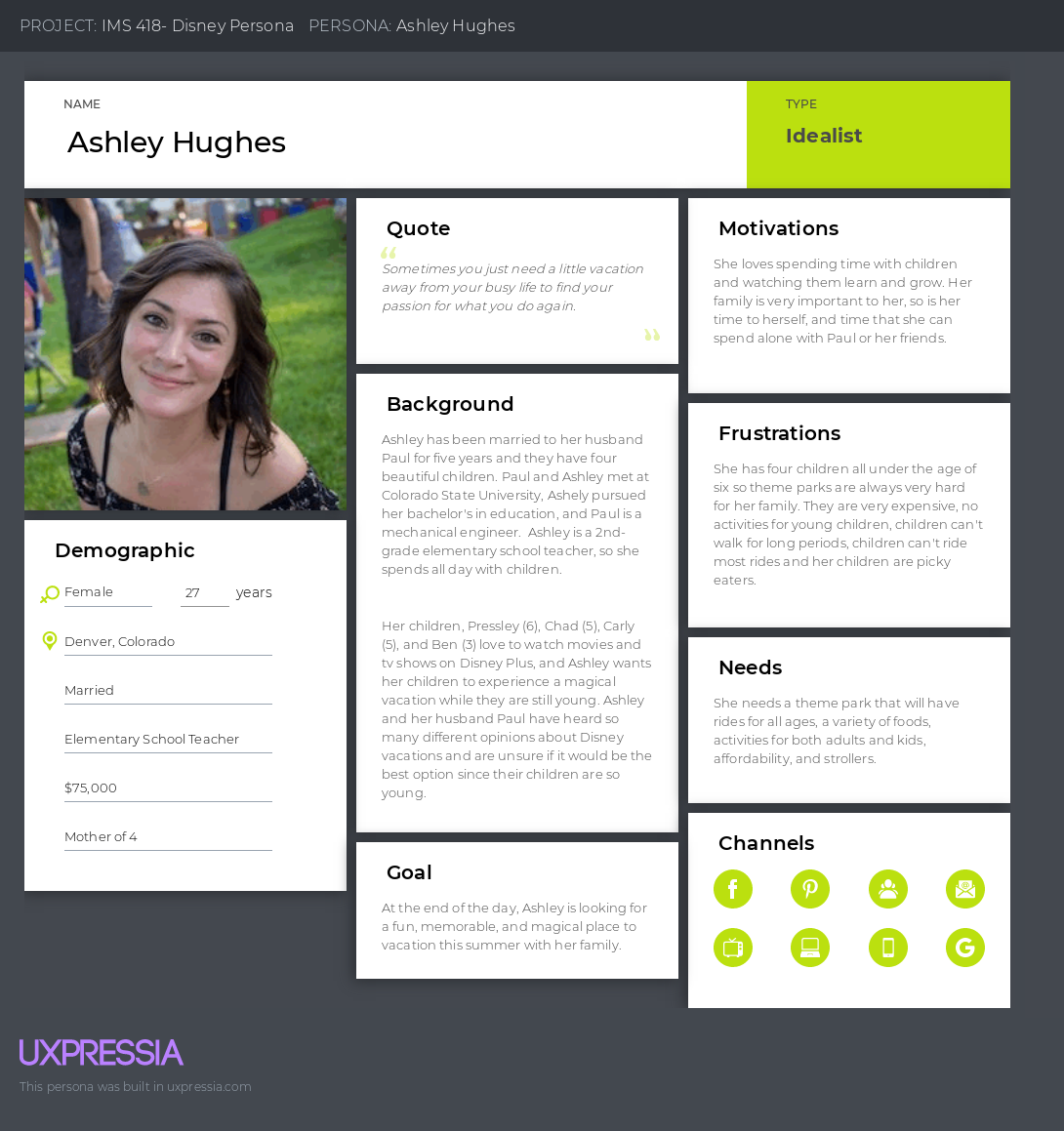
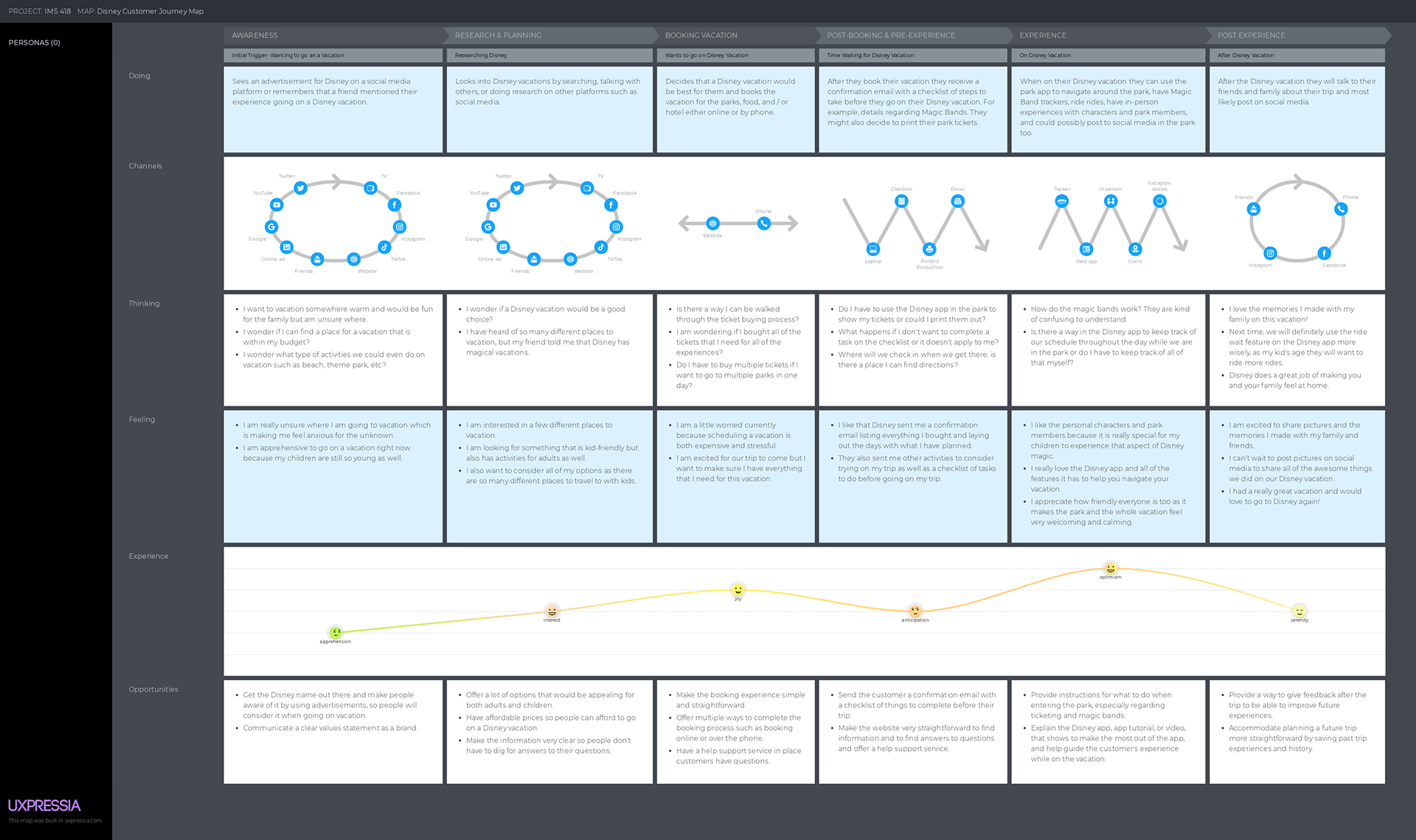
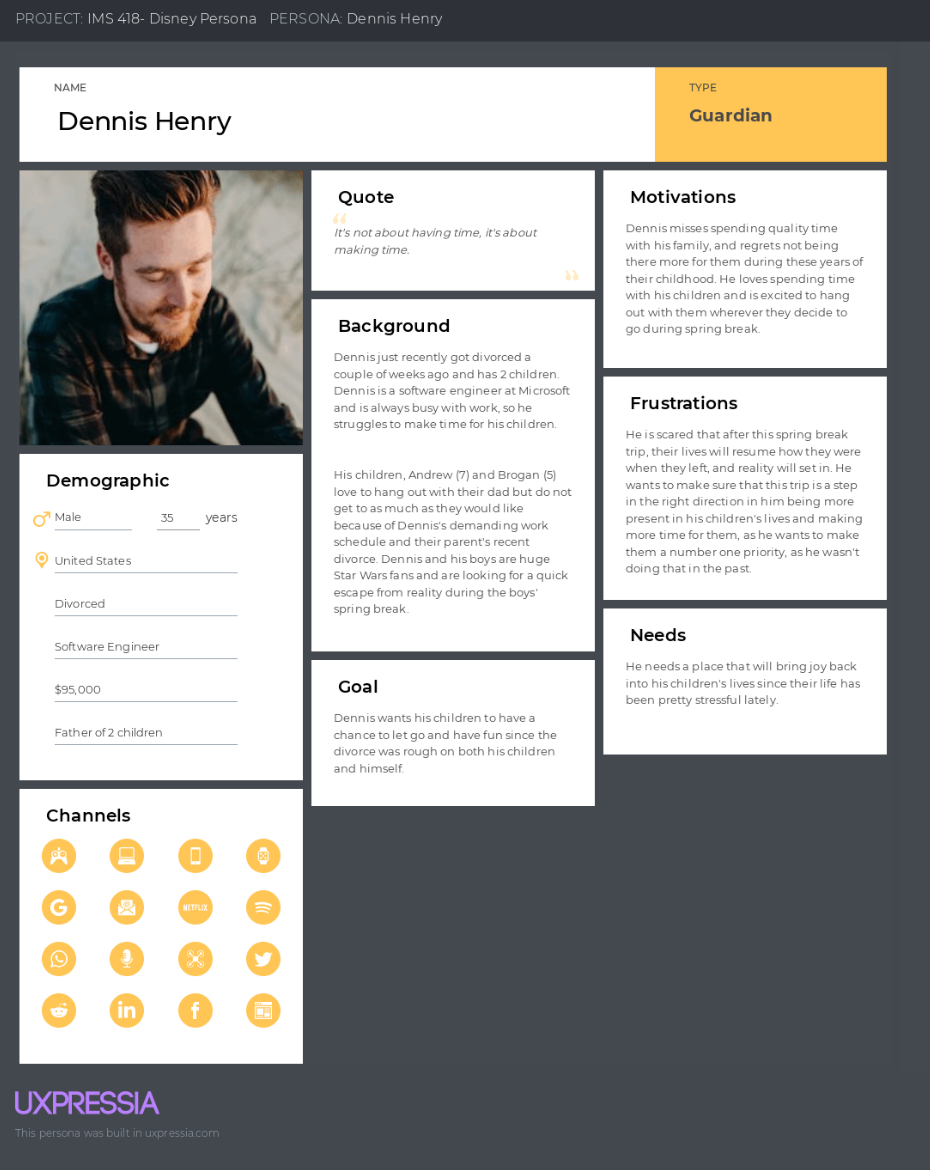

Frameworks
I think that one of the frameworks that would work well for my plan would be the Customer Decision Journey. The initial trigger would be that someone would want to go on vacation with their family. So then they do research and remember that they have seen ads for Disney vacations in the past. They decide a Disney vacation would be the correct choice for their family so they buy tickets, after they buy tickets they receive confirmation emails and what they should do to prepare. Then they enjoy their vacation and after sharing pictures about their vacation, Disney could offer them incentives to come back for another vacation in the future. Another framework that supports my plan, would be The Trifecta, as in the ways to characterize how my plan is doing. For instance, Disney could start posting the ads on their own social media account which would be considered owned media. Eventually, Disney could pay to have their content shown to targeted audiences as well, as mentioned in my plan, people with families on Instagram and Facebook. This would be considered paid media, and lastly, once people come to vacation at the park and share their vacation photos that would be considered earned media.
Attribution Model
Moreover, I think the attribution model that best fits my customer decision journey would be a linear attribution model, where this model gives insights before and after the first interaction with the brand. In my customer journey, my persona comes into contact with my brand several different times during their conversion journey because they not only could know about Disney from the parks but also Disney Plus, Disney merchandise, etc since Disney is such a large company.
Campaign Goal
In regards to my brand, Disney, an example of a campaign goal would be to have more people come to Disney parks. This is a direct consequence of my journey maps because a lot of families cannot decide where to go on vacation, and the goal for Disney is to beat their competition. Both of my customer journey maps are for parents that cannot decide where to vacation with their families/children, the goal for Disney is ultimately to get them to decide to take a trip to a Disney park.
Objective
An example of an objective would then be to increase the number of families that come to Disney parks by 50%.
Strategies
An example of a strategy would then be to make more Disney advertisements. Then an example of a strategy would be to target users with families on Instagram, Facebook, and Twitter with ads that show families having a fun time at Disney parks. Another strategy Disney could implement would be to use engine optimization to its full potential, so when a customer is looking for family vacations, Disney would be one of the first results on the SERP.
SEO Audit
On-Page
There are a lot of things that Disney is doing well, and there are a few things that they could improve upon. In regards to title tags, Disney has optimized them very well, as there is a different title tag for every page, it includes the brand name in the title and is ranked very high on the SERP. The description tag is also SEO optimized, as it is concise, “Plan a Disney family vacation with helpful travel planning information and experience the magic of Disney Theme Parks, cruises, and exciting destinations.” In terms of header tags, these pop up on the SERP as well. The four headers that are shown on the SERP are Disney Tickets & Annual Passes, The official blog for Disneyland, Vacation Packages, and Vacation Planning. These headers are the first four tabs that can be clicked on by users on the Disney Park website. Disney’s image optimization definitely could be improved as they aren’t using the next-gen image format at all, and their alt tags aren’t being optimized to their full potential. Additionally, the file names of the images on the website are not very descriptive of what the images are showing. In terms of content optimization, Disney isn’t in the sweet spot of word count, as a lot of their pages mostly have images on them. Disney doesn’t keyword stuff, but they use the most popular keywords in their content on their pages whenever possible.
Off-Page
In regards to off-page SEO, it is hard to know how Disney is doing in terms of link-building, but referencing the place that they are on the SERP, I would assume doing very well, as the content on their website is high-quality. Disney’s content meets all of the good content qualifications as it is accurate, clear, concise, provides unique detail or insight, includes a variety of media, and is updated regularly. Disney uses passive and paid outreach link-building strategies the most. Moreover, Disney uses the rel=”nofollow” addition in the HTML to a lot of the different pages on their website, as Disney wants their homepage to be the highest Disney page ranked on the SERP. So when people link to those other Disney pages, it increases the ranking of the main Disney homepage on the SERP. I think that Disney has some strategies that they use already to build link equity, acquiring other websites to link to Disney’s website, which is very important.
Technical
In regards to Disney’s technical SEO, they do have a robots.txt page but there is nothing on it, so Disney should fix that. When I ran the mobile-friendly test, it showed that Disney.com is a mobile-friendly site. Additionally, the website is secure regarding SSL, and in regards to the schema, there are many improvements that Disney could make. For instance, when I did my audit on Disney using SEMrush Disney was only using h1 tags in their HTML, for the schema to work you need to use all sorts of different tags. Also, when I used the Schema Google plugin it said that Disney.com has no structure whatsoever, and Disney uses a lot of text in their images which the search engine can’t see in the HTML. In regards to site speed for both mobile and desktop, the speed was really slow, as the images that Disney uses on their website are not in a next-gen format which makes the website take so much longer to load.
Keywords
Disney has a lot of popular keywords but the most popular ones that would relate to my customer journey maps would be Disney (CPC 3.6 and Keyword Difficulty 100%), Disney Parks (CPC 1.2 and Keyword Difficulty 97%), Disney Vacation (CPC 1.6 and Keyword Difficulty 100%), Disney Parks Blog (CPC 0.6 and Keyword Difficulty 76%), Star Wars Galaxy’s Edge (CPC 0.7 and Keyword Difficulty 75%), Downtown Disney (CPC 0.3 and Keyword Difficulty 86%), Disneyworld (CPC 0.5 and Keyword Difficulty 100%), and Disney Trip (CPC 0.7 and Keyword Difficulty 82%). These keywords all relate to my journey map. After all, they are all keywords that my personas would potentially search for on the SERP because they all relate to their specific interests in a vacation or more generally just a Disney vacation.
SEO Recommendations
In terms of SEO recommendations, I think that Disney is doing well, but there are a couple of aspects that Disney could improve upon. In regards to on-page SEO, I would recommend that Disney use fewer images, as a lot of their pages are very image-heavy. Other than that I think that their on-page SEO is in pretty good shape. In regards to off-page SEO, I think that there are a lot more opportunities that Disney could take advantage of in terms of link building. I think that Disney already does pretty well with building link equity, but there is always room for improvement in this area with any brand. Lastly, when it comes to technical SEO there are a few aspects that could be improved for Disney. For instance, Disney has a robots.txt page but there is nothing on it, the page is completely blank. Also, when looking at the schema Disney was only using h1 tags in their HTML, and for SEO it is important to use multiple different tags to show the structure of the website. Moreover, because Disney uses so many images on their website that aren’t in a next-gen format the loading speed for their website is pretty slow, compared to if Disney used fewer images or if the images were in a next-gen format.
Display/Programmatic Ads
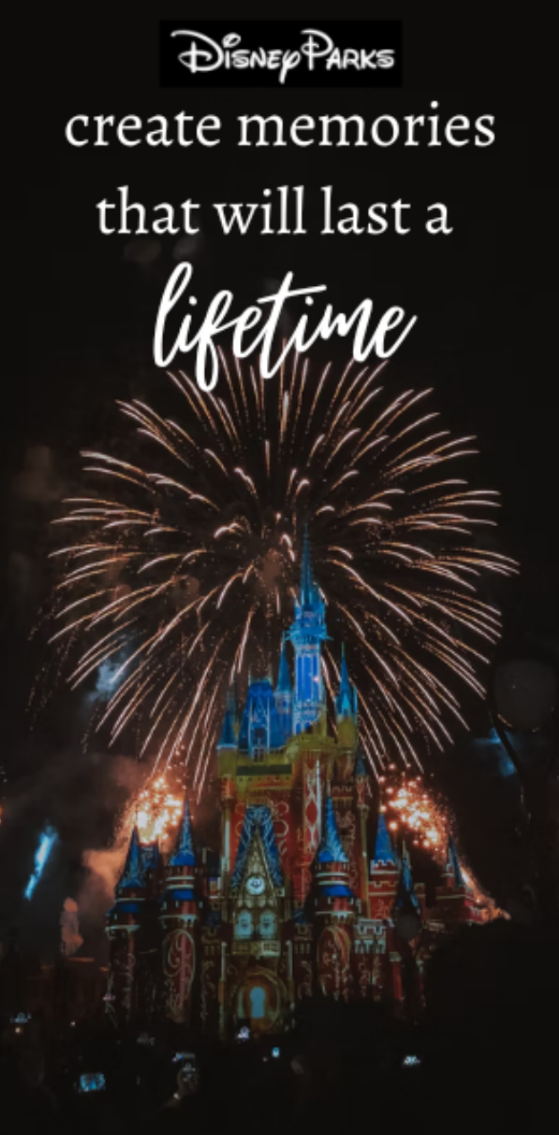
Half-Page Display Ad
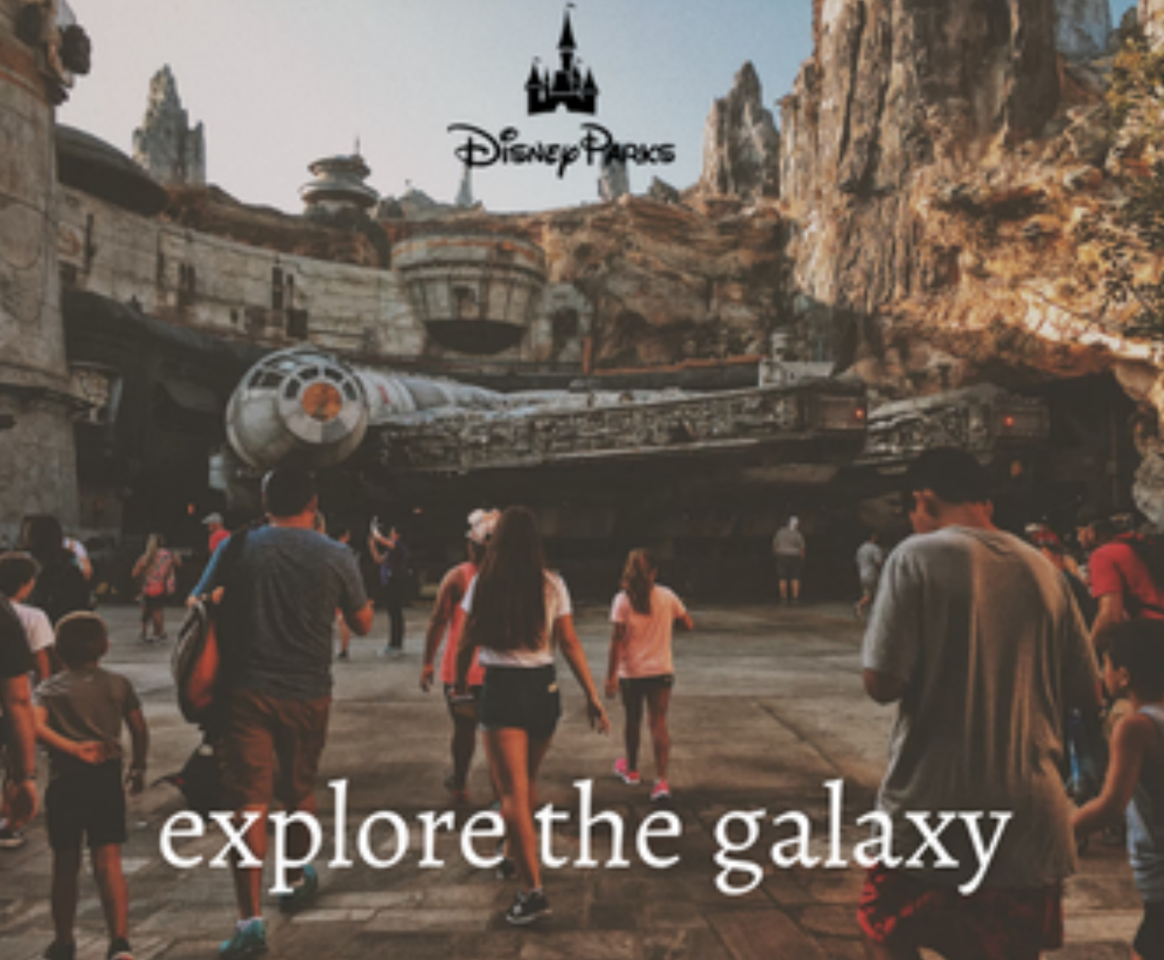
Large Rectangle Display Ad
If I were to create a programmatic strategy for the half-page display ad, the first step would be to set a goal for this campaign, increasing the number of people coming to Disney parks. Next, it is important not to set a fixed budget, remain flexible, and make initial measurements of where Disney is starting to track growth. After that, it is crucial to target your ads to a specific audience, so for this ad, I would probably target it towards females using desktop devices, ages 20-35, living in The United States, living in Colorado, who spend a lot of time online shopping or browsing the internet, and are interested in family topics and travel, if I was following Ashley’s Customer Journey Map. When the ad is clicked on by the user it would take them to the Disney parks homepage. Then, I would choose a DSP that values brand safety and that would help Disney accomplish their goal. Lastly, I would track the ad performance and adjust the content to improve it if needed.
If I were to create a programmatic strategy for the large rectangle display ad, the first step would be to set a goal for this campaign, increasing the number of people coming to Disney parks. Next, it is important not to set a fixed budget, remain flexible, and make initial measurements of where Disney is starting to track growth. After that, it is crucial to target your ads to a specific audience, so for this ad, I would target males using desktop mobile devices, ages 25-40, living in The United States, who spend a lot of time browsing the web and are interested in vacations, family, work, and science fiction, if I was following Dennis’ Customer Journey Map. When the ad is clicked on by the user it would take them to the Disney parks page that talks about the Galaxy’s Edge Park. Then, I would choose a DSP that values brand safety and that would help Disney accomplish their goal. Lastly, I would track the ad performance and adjust the content to improve it if needed.
Influencer Tactics
Influencer marketing is no longer a tactic, it is a strategy. If I were to run an influencer marketing campaign for Disney I would first look at my Customer Journey Maps to see where an influencer could benefit from the opportunities. When looking at the Customer Journey Maps that I created for Disney I think the awareness opportunity would benefit from influencer marketing, to get Disney’s name out there more. The audience I am trying to target fits both of my personas, so males and females between the ages of 20-40, living in The United States, interested in travel, vacations, and family. I would measure the success of this campaign if more people become aware of Disney as a brand, which would potentially correlate with more people coming to Disney Parks. I would want my campaign to run on Facebook as my targeted demographic uses that platform. From my research, I think a Facebook influencer that would be a good fit is Tom Bricker Photography, as he already posts a lot of Disney-related content and has 3k followers (nano influencer). Tom is an amateur travel blogger and photographer in his free time and is an attorney, so his fans value his authenticity, and because he already posts Disney-related content, I think that this could increase Disney’s brand awareness.
Facebook Audit & Competitor Analysis
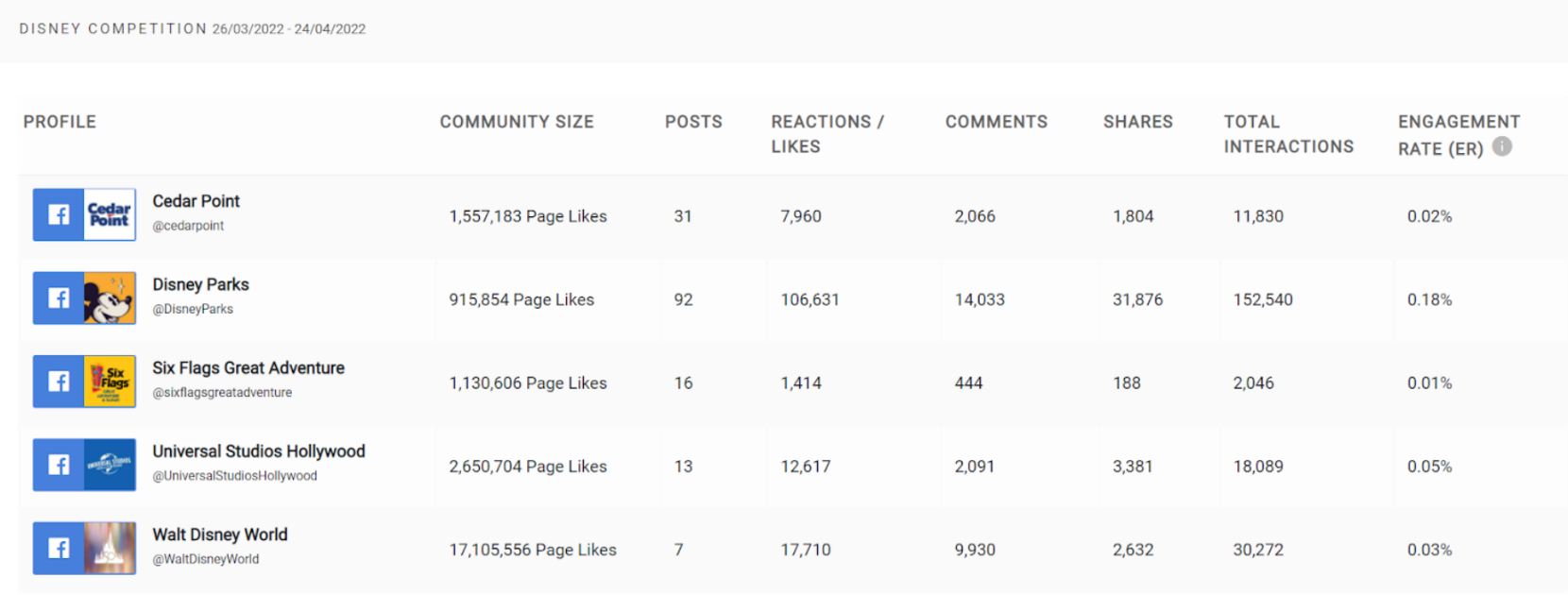

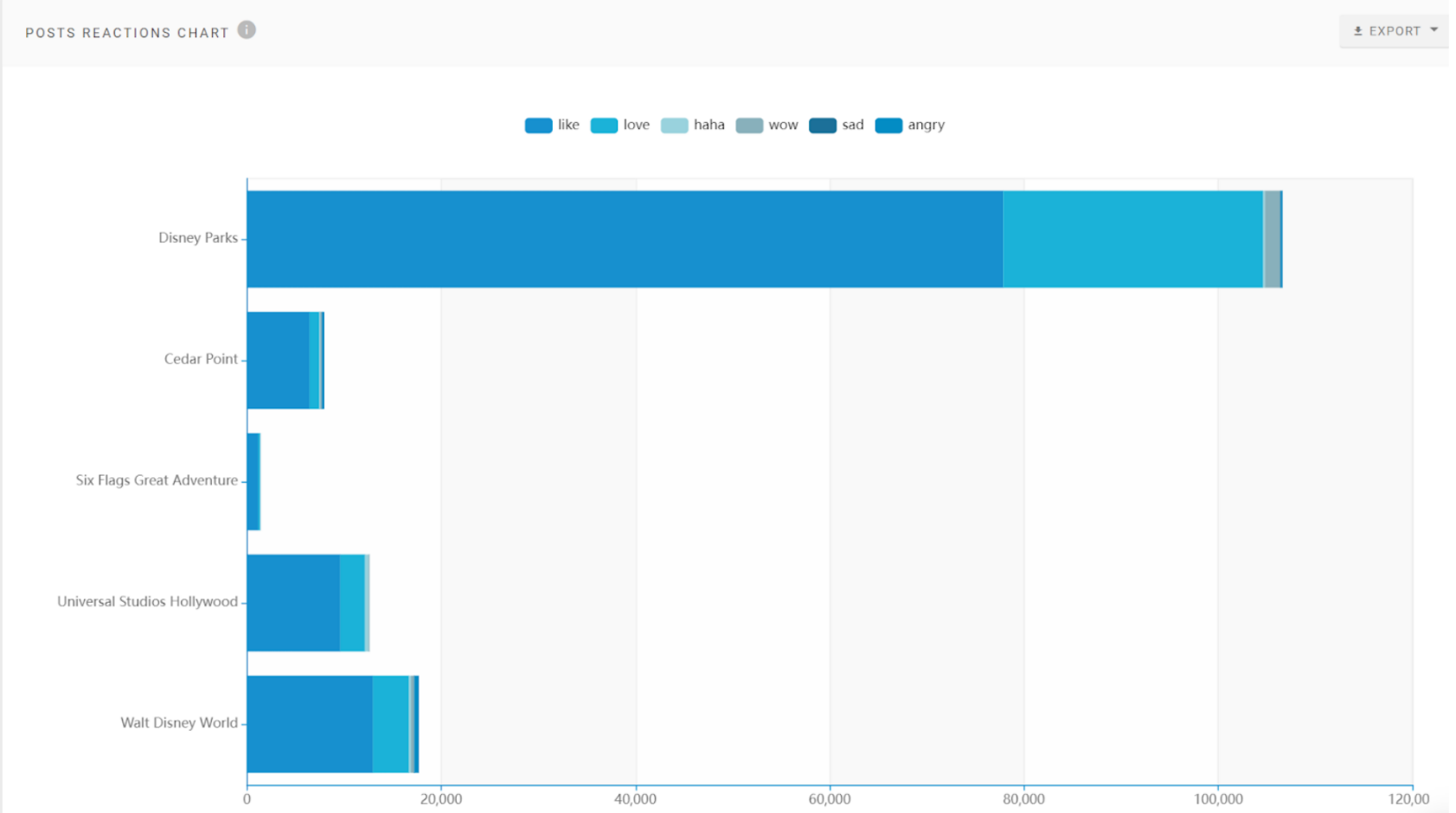
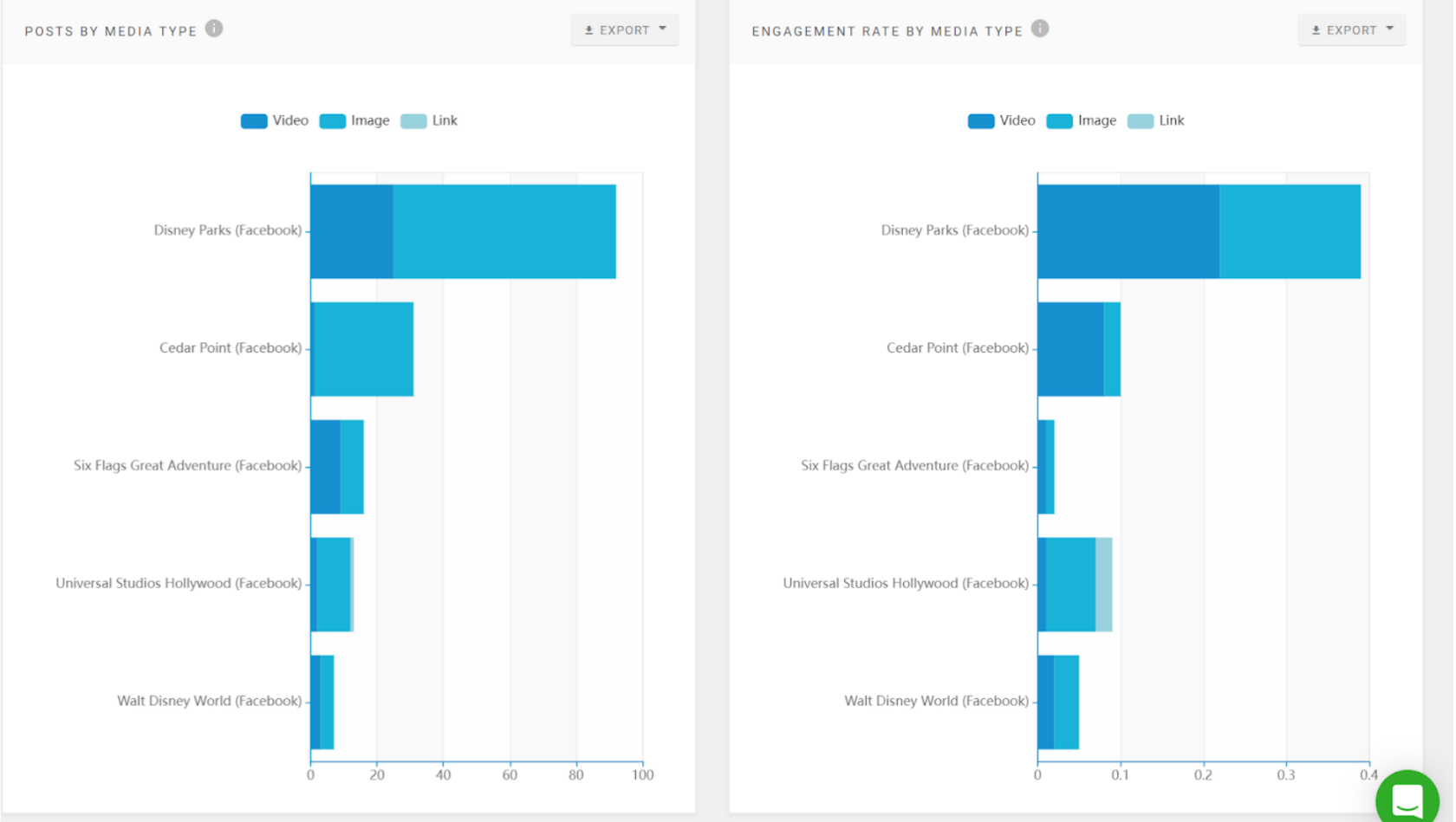
Organic Facebook Tactics
The mockup posts that I made cover a variety of different topics, controversy, video content, user-generated content (UGC), charitable values, and new attractions. It is important to use Facebook to promote your brand because Facebook is the number one social media platform worldwide. Additionally, 1 in 7 people use Facebook, and 2.79 people worldwide are using Facebook on a regular basis. That being said, if you aren’t using Facebook to promote your brand it is a huge missed opportunity.
Paid Facebook Tactics
Ad Set #1: Women Ages 20-40
The specifications for this ad set would be women, ages 20-40, living in The United States, living in Colorado, and are interested in family, children, Disney, vacations, trips, activities, fun, theme parks, amusement parks, magic, memories, and family-friendly activities.
Ad Set #2: Men Ages 20-40
The specifications for this ad set would be men, ages 20-40, living in The United States, and are interested in technology, vacations, family, work, science fiction, Star Wars, Disney, trips, vacations, single fathers, and fun.
Twitter Tactics
I think that implementing Twitter into Disney's social media marketing plan would be very beneficial because Twitter is a great platform for brands to provide quick customer service and support, allows brands to share unique content, expands audience reach, and works as a search engine tool to see what competitors are doing. Disney already has a current Twitter platform, but especially Disney Parks Twitter is lacking in content and does not have a consistent posting schedule. One feature of Twitter that I think Disney Parks could really benefit from is the Ads feature as it allows brands to pick different objectives for their ad content as well. I think that Disney Parks should create a Twitter ad campaign with the objective of increasing website conversions, as the goal is to get more people to come to Disney Parks. Ads with the objective of website conversions will get more people looking at the Disney Parks website, and potentially booking a Disney vacation.
Mockup Twitter Ad
Audio Content Marketing Tactics
I think that there is a lot of potential in audio content marketing for Disney Parks, as they currently have some such as a few podcasts, but I think there is a lot more that they could be doing as well. For instance, I think that it would be beneficial if they used Spotify and made a playlist of Disney songs, so fans and customers could share them and listen to the music that is played in the Disney Parks at home.
Not only would I think that implementing a Spotify playlist would be beneficial for Disney Parks, but I also think that using an app such as Clubhouse or another audio room network would be a beneficial way to chat with customers and gain insightful feedback. When I was looking throughout Clubhouse a few audio rooms that stood out to me that would be beneficial to engage with would be the Disney & Musical Club, All Disney, and The Real Talk Room. These rooms already talk about Disney or topics that are similar. If Disney were to host their own audio room, I think that it would be beneficial to talk about inside facts about Disney, or new and intriguing things that would be exclusive to the audio room to gain listeners.
As mentioned before, Disney has a few podcasts of their own, but it would also benefit Disney if it advertised on other podcasts. A few podcasts that I think Disney should advertise on would be Famtastic Four, The Dis Unplugged, and Rope Drop Radio. I think that it would be beneficial to advertise on Famtastic Four because it is a lifestyle and parenting podcast for adults, so the target audience would be the same. Additionally, I think that advertising on The Dis Unplugged, and Rope Drop Radio would be beneficial as well because they already talk a lot about Disney on those platforms, so it would be a good way to get the word out more about exclusive Disney details.
Pinterest Tactics
Disney Parks do not currently have its own Pinterest profile, but Disney World and Disneyland both have their own individual accounts. The Walt Disney World Pinterest account currently has 443.9k followers and 10 million monthly views. The Disneyland Resort Pinterest account has 107.6k followers and 3.3 million monthly views. The Walt Disney World account posts more content that is curated specifically for Pinterest, as the Disneyland account looks like the content could possibly be reused on other platforms as well. Some changes that both accounts could implement would be, to make sure that Pinterest board titles are both keyword and SEO optimized, and to repin, comment, and engage as a brand.
Pinterest is a very popular app for e-commerce. Disney already uses Pinterest advertising, but for the specific goal of increasing the number of people that go to Disney Parks, I think that it would be beneficial to run a campaign with the main objective of either building brand awareness or driving traffic consideration. The audience for the campaign should be an engaged audience that is engaged with pins from Disney’s confirmed domain. Moreover, Pinterest has options for targeting by age, gender, location, language, device, keywords, and interests. Trends are a big deal on Pinterest, so as an advertiser, it is important to be up to date with any current trends. On another note, on the Disney Parks website, it is important to make sure that all of the images are pinnable and to include Pinterest in the brand’s other social media links.
YouTube Tactics
Disney Parks already has a YouTube channel that they optimize very well, as they have a consistent posting schedule and have 1.54 million subscribers. They currently post a variety of content on there such as tips for specific Disney parks, cast life videos, virtual ride videos, and exclusive Disney vacation content. If a brand isn’t using YouTube they are really missing out because YouTube is the second most popular search engine in the world, and some even consider it a search engine optimization strategy in itself. Additionally, I think that Disney’s channel is set up very well. For instance, they have their other social media links, playlists, relevant banner graphic, Disney logo profile picture, featured videos, and content organized in sections on their page.
Not only does Youtube have its own search engine optimization strategy, but it also has an advertising platform like most other social media platforms. There are numerous types of YouTube ads but for Disney’s goal to increase the number of people coming to the Disney Parks I think it would be beneficial for Disney to upload non-skippable in-stream ads as they are more expensive, but it forces the viewer to view the add and would potentially increase website conversions and the number of people coming to the Disney Parks because of the increased brand awareness.
